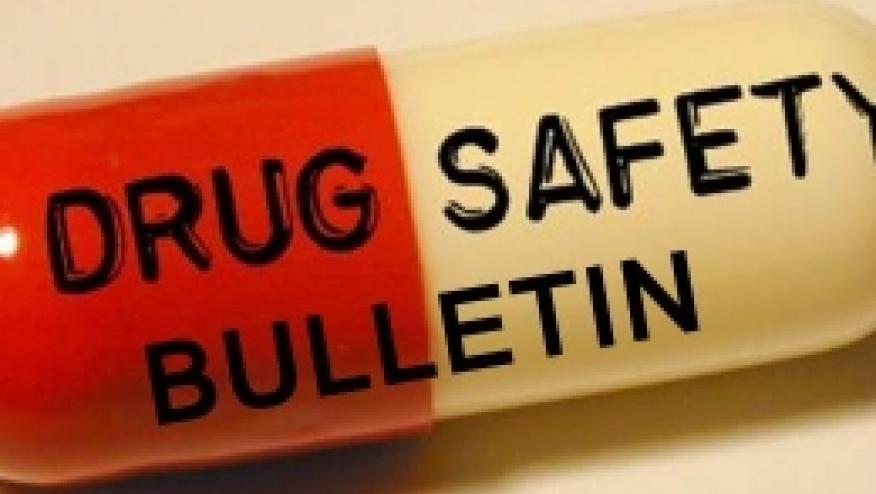DSB - Safety Update and Drug Shortages January 2017 Save

RheumNow will periodically report safety issues as Drug Safety Bulletins. These will update you with safety issues, label changes and reports of new, ongoing and resolved drug shortages that affect rheumatology. If you have suggestions or information about specific drug shortages or drug safety issues, please email us at info@rheumnow.com.
Drug Safety News
- PPI Safety Issues. This was the subject of an RN Review (http://rheumnow.com/content/ppi-safety-issues). Chronic use of PPI may be associated with a higher risk of severe, hypomagnesemia, 3-4 fold increase risk for C. difficile and Campylobacter infections, acute kidney injury, chronic kidney disease, and decreased bone density with a subsequent fracture risk.
- A Low Risk of Inflammatory Bowel Disease with IL-17 Inhibition. This subject was addressed at the ACR 2016 meeting by Dr. Deodhar (for secukinumab) and a recent literature report for ixekizumab. Overall the risk of either Crohn’s or ulcerative colitis is rare, ranging from 1 per 10,000 to 2 per 1000. These events were not dose or duration dependent and may be slightly higher in ankylosing spondylitis patients. http://buff.ly/2jxwXSU
- Risk of Herpes Zoster with Biologics. This was reported by Dr. Cassie Calabrese in a review of 40 RCTs and over 20,000 patients. They found that biologics increased the risk of HZ by 58-71%, with a lesser risk for DMARDs and the highest risk with tofacitinib. http://buff.ly/2k03KmE
- New American Academy of Ophthalmology (AAO) Recommendations for Hydroxychloroquine Screening. The new recommendations are based on a single 2014 study evaluating the prevalence of and risk factors for hydroxychloroquine retinal toxicity. (Citation source http://buff.ly/2dWimB0). The study showed that doses < 5mg /kg had a < 1% risk of HCQ retinopathy in the first 5 yrs. (< 2% in 10 yrs. and 20 % after 20 yrs.) The new AAO guidelines say that with starting HCQ, a fundus examination is needed within the first year of use and visual fields and Spectral Domain Optical Coherence Tomography is added when maculopathy is present. Thereafter, no further screening is needed for 5 years and then becomes annual. Sooner if there are major risk factors. Not all rheumatologists are on board with these guidelines – as voiced by Dr. Sergio Schwartzman’s blog on the topic. (http://buff.ly/2j5XJWD)
- Breastfeeding with Certolizumab Deemed Safe. A prospective analysis of 18 nursing mothers on certolizumab showed that breast milk contained little to no drug. The results of the CRADLE study were presented at both the GI and rheumatology meetings this year. http://buff.ly/2j5NOAm
- French Cannabinoid Trial Blamed for Faulty Dosing. In January 2016 we reported on a phase I trial gone wrong when 6 volunteers, receiving a new medication to treat mood disorders and appetite(BIA 10-2474 - an analgesic endocannibinoids) were admitted to the hospital. One died and 4 were left with permanent neurological damage. A safety review claims the Portuguese manufacturer, Bial, failed to use certain pharmacodynamic (PD) data when deciding to administer a higher dose that proved deadly. http://buff.ly/2j56IXW
- The Perils of Polypharmacy. Fortune magazine published a perspective on this serious public health problem. Polypharmacy increases the odds of untoward drug interactions. Three problems are pointed out: 1) drug alerts (interactions or polypharmacy) are often ignored because we live with automated systems that have so many alerts that they often go unheeded or are deemed irrelevant; 2) Pharmacists are complicit in the faults of physicians guilty of polypharmacy; and 3) “financial squeeze” is also to blame when these problems are overlooked. http://buff.ly/2j51aMW
- AMA Monograph on Patient Safety for Resident Training. The AMA Clinical Learning Environment Review (CLER) Program was created to provide U.S. teaching hospitals, medical centers, health systems with feedback and training in specific areas, including patient safety, health care quality and professionalism. One issue provides reviews challenges and steps to better patient safety training for residents, fellows. http://buff.ly/2jx7rNI
- FDA Drug Safety Priorities 2015-2016 - was published in 2016 and details both the FDA’s key safety priorities as well as the depth and versatility of drug safety initiatives across CDER and the FDA. The report includes program updates and milestones achieved since the start of 2015, describing several of the FDA’s most important efforts in drug safety science, surveillance, and oversight. The report seeks to offer a broad picture of current safety efforts, and highlights the critical advantages gained in safety science through a range of multidisciplinary collaborations and partnerships—within CDER and across the FDA, and with stakeholders from other government agencies, patient communities, industry, and academia. (http://buff.ly/2kiWoZc) In addition to the FDAs AERS (MedWatch) reporting system, there are several new and evolving initiatives designed to get earlier safety signals or warnings from multiple sources. This includes the Sentinel System (“Big Data” on 193 million persons in electronic health databases), the Jump Start program, integration of the Active Risk Identification and Analysis (ARIA) System, DARS (Division of applied regulatory science), Critical Path Initiative, Public-Private Partnerships on drug safety and the FDA’s efforts in opioid addiction and abuse (development of educational programs, post-marketing studies and REMS programs). There are programs focusing on the safety of opioids, generics and compounded drugs. Lastly the FDA intends to expand its education and reporting through various channels including more social media involvement.
FDA Updates – October – January 2017
- FDA withdraws black box warning (for depression, suicide) on Chantix. After review of an independent advisory board the FDA withdraws a decade old black box warning for depression and suicide for Chantix. They also noted Chantix was more effective than other anti-smoking approaches. December 2016 http://buff.ly/2kiElT2
FDA Safety Labeling Changes: drug label changes October 2016 – January 2017:
- Ambien (Dec 2016): “GABA agonists such as zolpidem tartrate have been associated with precipitation of hepatic encephalopathy in patients with hepatic insufficiency. In addition, patients with hepatic insufficiency do not clear zolpidem tartrate as rapidly as patients with normal hepatic function. Avoid AMBIEN use in patients with severe hepatic impairment as it may contribute to encephalopathy.” There are reports of acute hepatocellular, cholestatic or mixed liver injury with or without jaundice (i.e., bilirubin greater than 2x ULN, alkaline phosphatase greater than or equal to 2x ULN, transaminase greater than or equal to 5x ULN). Avoid AMBIEN use in patients with severe hepatic impairment as it may contribute to encephalopathy.
- Benlysta (Dec 2016): “exercise caution when considering the use of BENLYSTA in patients with severe or chronic infections....The most common serious adverse reactions were serious infections (6.0% and 5.2% in the groups receiving BENLYSTA and placebo, respectively), some of which were fatal. Benlysta also has its own pregnancy registry.
- Serotonin Syndrome (Dec 2016): added warnings to Cymbalta and Savella labels: The development of a potentially life-threatening serotonin syndrome has been reported with SNRIs and SSRIs, alone but particularly with concomitant use of other serotonergic drugs (including triptans, tricyclic antidepressants, fentanyl, lithium, tramadol, tryptophan, buspirone, amphetamines, and St. John’s Wort)… If concomitant use of Savella with other serotonergic drugs including triptans, tricyclic antidepressants, fentanyl, lithium, tramadol, buspirone, tryptophan, amphetamines, and St. John’s Wort is clinically warranted, patients should be made aware of a potential increased risk for serotonin syndrome, particularly during treatment initiation and dose increases.
- Ultram (Dec 2016): Boxed warning – “WARNING: ADDICTION, ABUSE, AND MISUSE; LIFE-THREATENING RESPIRATORY DEPRESSION; ACCIDENTAL INGESTION; NEONATAL OPIOID WITHDRAWAL SYNDROME; INTERACTIONS WITH DRUGS AFFECTING CYTOCHROME P450 ISOENZYMES; and RISKS FROM CONCOMITANT USE WITH BENZODIAZEPINES OR OTHER CNS DEPRESSANTS”
Reported Drug Shortages as of March 2, 2016
|
Drug Shortage |
Reason for shortage |
Estimated Availability |
|
Dexamethasone (4 mg/ml) vials |
Fewer manufacturers |
Unknown |
|
Epinephrine injection (1 mg/mL, 1 mL ampule, preservative free, sulfite-free) |
Product discontinuations, increased demand, . |
Intermittent availability; on backorder |
|
Lidocaine injection, 1%, 2% (2 ml, 5 ml, 10 ml vials) |
Manufacturing delays, increased demand, supply interruptions |
Intermittent availability; projected resolutions for late March or May 2016 |
|
Methotrexate injection (25mg/ml - 2 ml, 4 ml, 10 ml preservative free vials) |
Unknown, manufacturing delays |
Intermittent back order; resolution date unknown, but after 2/1/17. |
|
Source: http://www.ashp.org/DrugShortages/Current(link is external)http://www.accessdata.fda.gov/scripts/drugshortages/default.cfm(link is external) |
||







If you are a health practitioner, you may Login/Register to comment.
Due to the nature of these comment forums, only health practitioners are allowed to comment at this time.